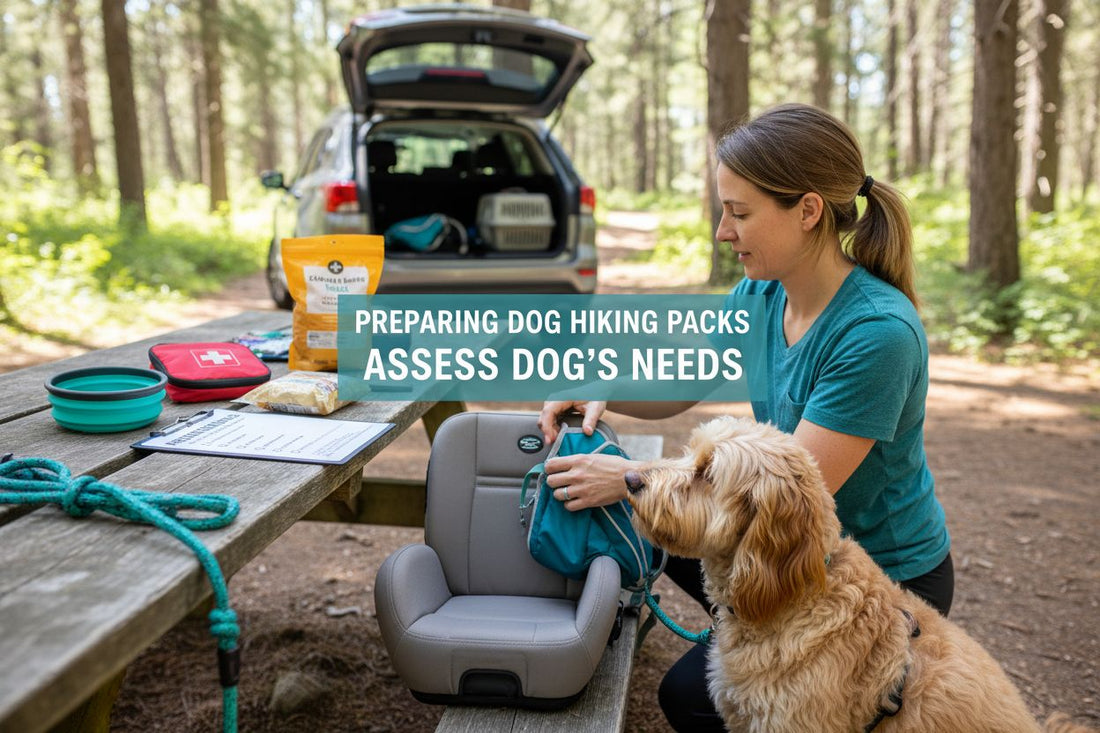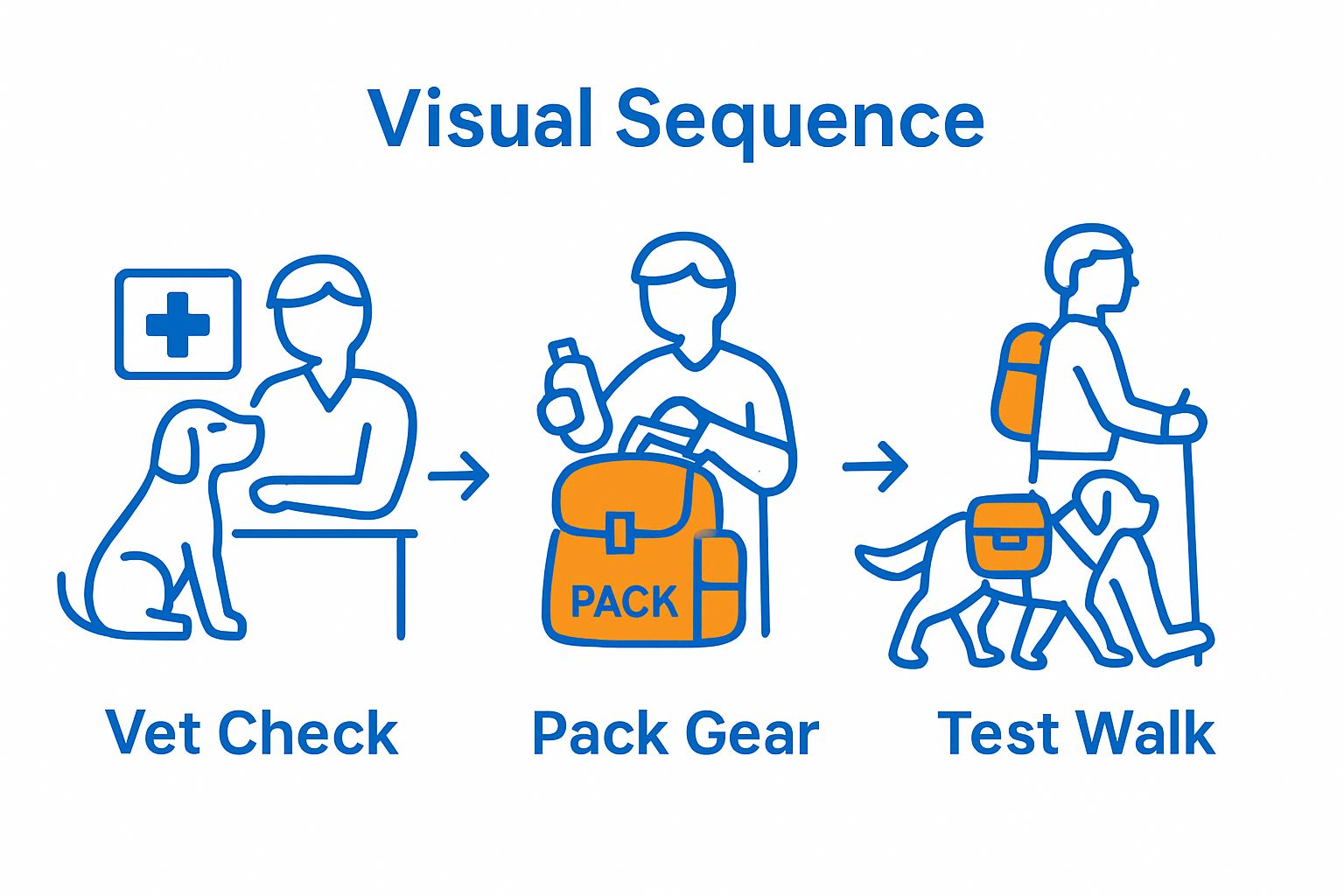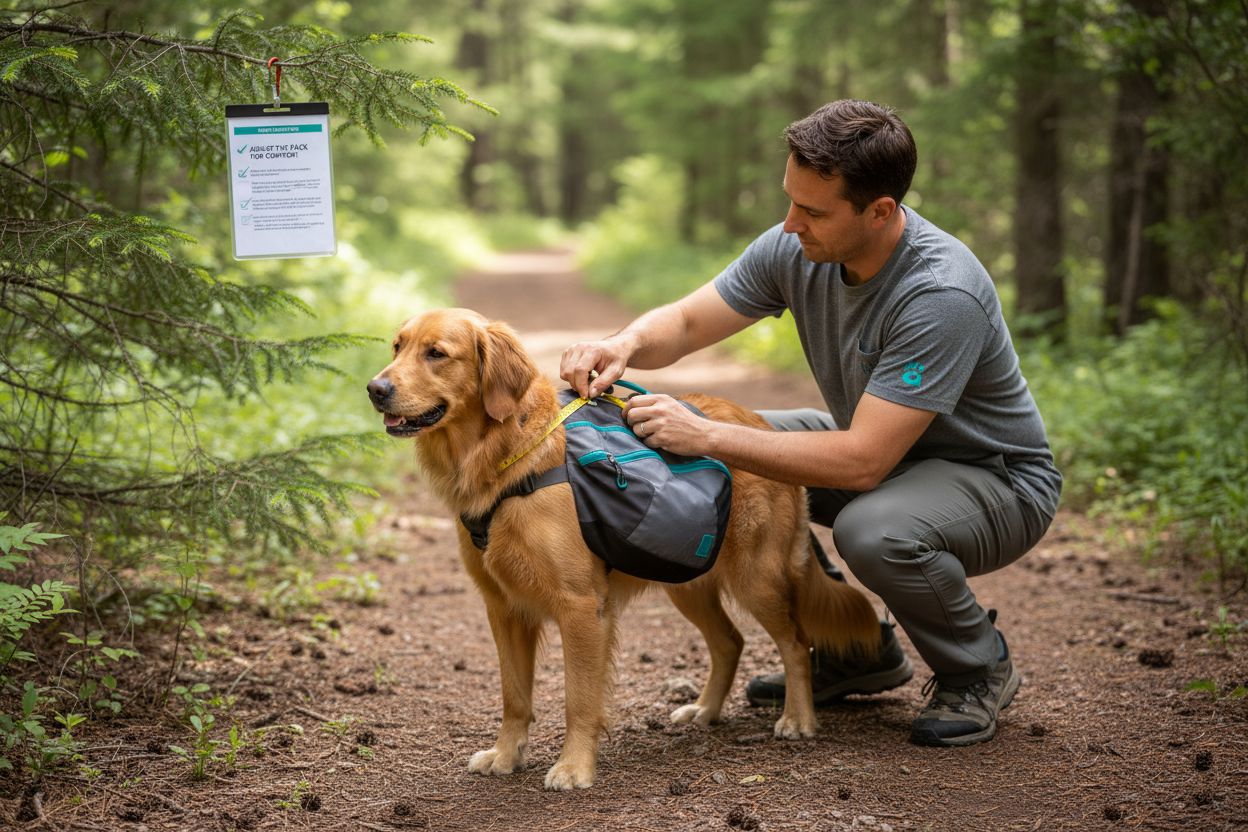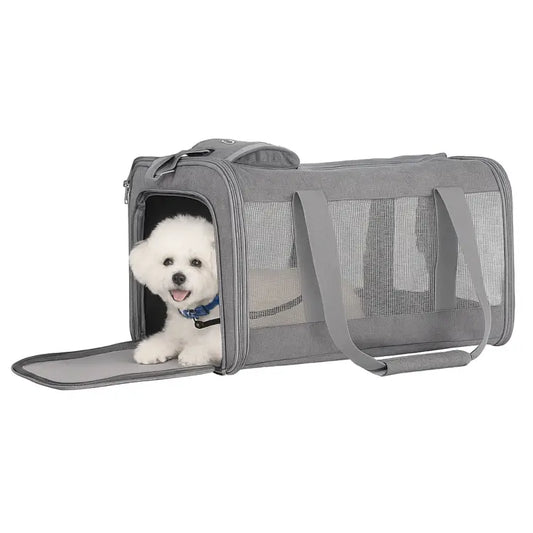
Preparing Dog Hiking Packs: Essential Steps for Safe Travel
Share
Packing for a dog-friendly hike sounds simple, but every furry companion has different needs that can make or break your adventure. Most owners are surprised to learn that a dog should only carry about 10-20 percent of their body weight in a pack. That number is actually lower than many expect. The real challenge is not just the gear, but how well you match and adjust each detail to your dog’s individual fitness and comfort.
Table of Contents
- Step 1: Assess Your Dog’s Needs And Gear Requirements
- Step 2: Gather Essential Items For The Hiking Pack
- Step 3: Pack And Organize Items For Easy Access
- Step 4: Adjust The Pack For Comfort And Safety
- Step 5: Verify Packing Essentials Before Departure
Quick Summary
| Key Point | Explanation |
|---|---|
| 1. Assess your dog’s fitness before hiking. | Schedule a vet checkup to ensure your dog is healthy enough for hiking and understand their weight capacity. |
| 2. Pack essentials for hydration and nutrition. | Include water, collapsible bowls, and high-energy dog snacks to sustain your dog during hikes. |
| 3. Organize pack for quick access. | Strategically distribute weight and categorize items to easily retrieve essentials while on the trail. |
| 4. Adjust the pack for your dog’s comfort. | Ensure the pack fits well; check for proper strap positioning and signs of discomfort during practice sessions. |
| 5. Verify crucial items before departure. | Confirm all identification and pack integrity; conduct a final readiness check before heading onto the trail. |
Step 1: Assess Your Dog’s Needs and Gear Requirements
Preparing dog hiking packs begins with a comprehensive assessment of your canine companion’s specific travel requirements. Every dog is unique, and understanding their physical capabilities, health status, and individual temperament will determine the most appropriate hiking gear and pack configuration. Your initial evaluation will set the foundation for a safe and enjoyable outdoor adventure.

Physical Fitness and Health Considerations play a critical role in determining hiking pack readiness. Start by scheduling a veterinary consultation to confirm your dog’s overall health and fitness for trail activities. Dogs with pre existing joint issues, respiratory challenges, or limited endurance might require specialized gear or modified hiking plans. Your veterinarian can provide specific recommendations about weight-bearing capacity and recommend maximum pack weight based on your dog’s size, breed, and physical condition.
Size and breed characteristics significantly influence hiking pack selection and load-bearing potential. Smaller breeds typically handle less weight compared to larger, more muscular dogs. As a general guideline, a dog should carry no more than 10-20% of their body weight, depending on their physical condition and trail difficulty. Working breeds like Australian Shepherds, Border Collies, and Labrador Retrievers often adapt more readily to carrying packs, while brachycephalic breeds or senior dogs might require lighter loads or alternative transportation solutions.
Consider several critical factors when preparing your dog for hiking pack usage:
- Overall health and fitness level
- Age and physical condition
- Trail terrain and expected environmental challenges
- Duration and intensity of planned hiking routes
- Your dog’s individual comfort and stress tolerance
Before investing in a hiking pack, conduct short practice walks with a lightweight, empty pack to acclimate your dog to the new equipment. Watch for signs of discomfort, restricted movement, or anxiety. Gradual introduction and positive reinforcement are key to helping your dog feel comfortable with their new hiking gear. Check out our guide on adventure-ready dog gear for additional insights into selecting the right equipment for your furry hiking companion.
Step 2: Gather Essential Items for the Hiking Pack
After assessing your dog’s hiking readiness, the next critical phase involves meticulously selecting and assembling the right equipment for a safe and comfortable trail experience. Your hiking pack should function as a comprehensive emergency and comfort kit, strategically organized to address multiple potential scenarios during outdoor adventures.
Hydration and Nutrition Essentials form the cornerstone of effective hiking pack preparation. Pack lightweight, collapsible water bowls that are compact yet durable enough to withstand rugged trail conditions. Carry sufficient water for both you and your dog, calculating approximately one ounce of water per pound of your dog’s body weight for every hour of hiking. Include high-protein, nutrient-dense trail snacks specifically formulated for dogs, which provide quick energy and maintain electrolyte balance during extended outdoor activities.
Emergency preparedness demands a carefully curated first aid kit tailored specifically for canine trail needs. Your pack should include sterile gauze, self-adhering veterinary wrap, antiseptic wipes, tweezers, and emergency blanket. Include any personal medications your dog might require, plus extras like tick removers and paw protection balm. Learn more about comprehensive dog hiking gear checklists to ensure you do not overlook critical equipment.
Consider packing these critical items for your dog’s hiking adventure:
- Compact first aid kit with veterinary-specific supplies
- Sufficient water and portable water filtration system
- High-energy trail snacks and collapsible feeding dishes
- Weather-appropriate protective gear
- Emergency communication device
- Additional leash and identification tags
Weather protection represents another crucial consideration when preparing your dog’s hiking pack. Depending on your trail environment, include lightweight, quick-drying cooling vests for hot conditions or insulating layers for colder terrains. Waterproof jackets can protect against unexpected rain, while protective booties shield sensitive paw pads from rough or extreme surface temperatures. Always prioritize your dog’s comfort and safety by anticipating potential environmental challenges before hitting the trail.
The following table summarizes the main essential items to pack in your dog’s hiking backpack, along with each item’s core purpose and important notes for trail readiness.
| Item | Purpose | Notes |
|---|---|---|
| Water & Collapsible Bowl | Hydration on the trail | Estimate 1 oz per pound/hour; bring filtration if needed |
| High-Energy Dog Snacks | Nutritional support and energy | Choose nutrient-dense, trail-friendly snacks |
| First Aid Kit (Canine Specific) | Emergency preparedness | Include vet wrap, antiseptics, tweezers, medications |
| Weather-Appropriate Protective Gear | Comfort and safety in varying weather | Cooling vests, jackets, booties as suitable |
| Additional Leash & ID Tags | Safety and identification | Use updated tags; leash for control |
| Emergency Communication Device | Contact in case of emergencies | Fully charged, with backup batteries if possible |
| Collapsible Feeding Dishes | Convenient feeding and water access | Lightweight, packable, easy to clean |
Step 3: Pack and Organize Items for Easy Access
Effective packing transforms a potentially chaotic hiking experience into a smooth, well-orchestrated adventure. Strategic organization of your dog’s hiking pack ensures quick access to essential items while maintaining weight distribution and your dog’s comfort throughout the journey. The goal is to create a systematic approach that allows rapid retrieval of supplies without disrupting your hiking rhythm.
Weight Distribution and Balance represent critical considerations when loading your dog’s hiking pack. Position heavier items like water containers and first aid kits closer to the dog’s center of gravity, typically near the shoulders and spine. This placement minimizes strain and prevents shifting that could cause discomfort or potential injury. Lightweight items such as collapsible bowls, extra layers, and trail snacks should be distributed evenly on both sides to maintain equilibrium. Discover expert tips on organizing dog hiking backpacks to optimize your packing strategy.
Utilize waterproof, compartmentalized stuff sacks or compression bags to protect gear from moisture and create clear organizational zones within the pack. Color-coded or labeled bags help streamline item identification during quick stops or emergency situations. Implement a logical storage system where frequently accessed items like water, treats, and waste bags remain easily retrievable without complete pack unpacking. Consider the pack’s external attachment points for items requiring immediate access, such as a small towel or emergency whistle.
Prioritize these organizational strategies for optimal hiking pack preparation:
- Group items by functional categories (emergency, hydration, nutrition)
- Use waterproof and compression storage solutions
- Maintain balanced weight distribution
- Keep critical items within immediate reach
- Protect sensitive gear from environmental exposure
Before hitting the trail, conduct a comprehensive pack test during a short local walk. Observe your dog’s movement, check for any signs of discomfort, and make necessary adjustments. Ensure pack straps are snug but not restrictive, allowing full range of motion. Test the pack’s stability by gently shaking and walking to confirm items remain secure. A well-organized hiking pack not only enhances your dog’s comfort but also provides peace of mind knowing you are prepared for whatever the trail might present.
Step 4: Adjust the Pack for Comfort and Safety
Pack fitting represents a critical juncture between successful hiking preparation and potential trail discomfort for your canine companion. The adjustment process requires patience, precision, and a keen understanding of your dog’s unique physical characteristics. Proper pack fitting goes far beyond simple strap management and involves comprehensive evaluation of movement, weight distribution, and potential pressure points.
Precise Strap Positioning determines the pack’s overall performance and your dog’s comfort level. Begin by ensuring the pack sits high on the shoulders, allowing unrestricted shoulder movement while preventing shifting during walking or climbing. The chest strap should rest comfortably without restricting breathing, typically positioned about two inches behind the front legs. Check that straps are snug but not tight enough to create uncomfortable pinching or chafing. A good rule of thumb is being able to slide two fingers easily between the strap and your dog’s body. Learn more about proper dog hiking gear fitting techniques to ensure maximum comfort and safety.
The adjustment process requires multiple short practice sessions to help your dog acclimate to the new gear. Start with brief walking periods wearing an unloaded pack, gradually increasing duration and adding weight. Watch for subtle signs of discomfort such as altered gait, frequent stopping, excessive panting, or attempts to remove the pack. Some dogs adapt quickly, while others might require more extensive desensitization training. Pay special attention to areas prone to friction, including armpits, chest, and shoulders, checking for potential irritation or hair loss after each practice session.
Consider these critical adjustment verification points:
- Unrestricted shoulder and leg movement
- Even weight distribution
- No visible signs of chafing or skin irritation
- Consistent, natural walking pattern
- Comfortable breathing rhythm
Before embarking on longer trails, conduct comprehensive fit checks in controlled environments. Have your dog walk on different surfaces, navigate mild inclines, and perform basic movements to confirm the pack’s stability. Small adjustments made during these practice sessions can prevent significant discomfort during extended hiking adventures.
 Remember that each dog is unique, and what works perfectly for one might require modification for another. Patience, observation, and willingness to make incremental changes are key to finding the ideal pack configuration for your furry hiking partner.
Remember that each dog is unique, and what works perfectly for one might require modification for another. Patience, observation, and willingness to make incremental changes are key to finding the ideal pack configuration for your furry hiking partner.
Step 5: Verify Packing Essentials Before Departure
Final preparation represents the critical bridge between thoughtful planning and successful trail adventures. A systematic pre-departure verification process ensures you have not overlooked any crucial details that could compromise your dog’s safety or comfort during the hiking expedition. This comprehensive review transforms potential oversights into a reliable, well-executed outdoor experience.
Documentation and Identification form the foundational safety element of your pre-departure checklist. Confirm that your dog’s collar includes current identification tags with updated contact information, and consider microchip registration verification if you have not done so recently. Carry a printed copy of your dog’s recent vaccination records, emergency contact information for your veterinarian, and a basic medical history summary. These documents can prove invaluable in remote locations where immediate veterinary assistance might be challenging to access. Explore our comprehensive pet travel packing guide to ensure no critical items are forgotten.
Physical gear inspection involves a meticulous examination of every equipment component. Check pack integrity by testing all zippers, clasps, and attachment points for potential weakness or wear. Verify that water containers are leak-proof and inspect first aid supplies for expiration dates or signs of degradation. Review your emergency communication devices, ensuring batteries are fully charged and backup power sources are readily available. Perform a final weight assessment of the packed gear, confirming it remains within the recommended 10-20% of your dog’s body weight limit established during initial preparation.
Prioritize these final verification steps before trail departure:
- Confirm all identification and medical documentation
- Test pack structural integrity
- Verify emergency communication devices
- Review total pack weight
- Assess dog’s current physical and emotional readiness
Conducting a short walking test immediately before departure provides the ultimate preparedness assessment. Observe your dog’s demeanor, checking for any signs of stress or discomfort with the fully loaded pack. A calm, confident stance and natural walking rhythm indicate successful preparation.
Use this final packing checklist to verify that you have completed all essential readiness steps and ensured your dog’s safety and comfort before starting your hiking adventure.
| Final Check | What to Do | Why It Matters |
|---|---|---|
| Confirm Identification & Documentation | Ensure tags, contact info, and vaccination records | Quick access and safety in emergencies |
| Inspect Pack Integrity | Test zippers, buckles, and attachment points | Prevents gear failure on the trail |
| Verify Emergency Communication Devices | Test batteries and prepare backups | Ensures reliable communication |
| Review Pack Weight | Keep total gear within 10-20% of dog weight | Maintains comfort and avoids harm |
| Observe Dog Readiness | Assess demeanor and fit during test walk | Signals physical and emotional fitness |
| Check First Aid & Food Supplies | Confirm no expired, missing, or damaged items | Ensures readiness for trail scenarios |
Equip Your Dog for Every Trail with Trusted Hiking Solutions
You want safe adventures and lasting memories when hiking with your dog, but the wrong pack or missing essentials can quickly turn excitement into stress. If you have ever worried about choosing a comfortable, durable hiking pack or struggled with packing hydration, first aid, and weather protection, you are not alone. The article highlights how important it is to select, fit, and organize the right outdoor backpack, so your dog stays comfortable and secure throughout every journey.
Explore dog hiking backpacks built for real adventures featuring ergonomic design, lightweight materials, and safety-first touches.

Make every hike safer for your dog. Visit YappyBoo.store to find trusted gear, travel-friendly carriers, and summer trail essentials. Check out our summer dog travel essentials and enjoy exclusive offers and fast shipping. Secure your peace of mind on the trail and get your dog ready for the next adventure today.
Frequently Asked Questions
How do I assess my dog’s hiking readiness?
To assess your dog’s hiking readiness, consider their physical fitness, health status, and temperament. Schedule a veterinary consultation to determine their suitability for hiking and confirm their maximum pack weight based on size and breed.
What essential items should I include in my dog’s hiking pack?
Include hydration supplies, high-energy trail snacks, a first aid kit specifically designed for dogs, and weather-appropriate gear. Aim to pack items that ensure your dog’s comfort and safety while addressing potential emergencies during your hike.
How do I organize items in my dog’s hiking pack for easy access?
Strategically organize your dog’s pack by balancing weight and keeping heavy items near their center of gravity. Use waterproof, compartmentalized bags to categorize supplies and maintain quick access to frequently used items like water and treats.
What adjustments should I make to ensure my dog’s pack fits comfortably?
Ensure the pack sits high on your dog’s shoulders and is not restrictive around their chest. Adjust the straps to allow for two fingers to fit between them and your dog’s body, and conduct short training walks to check for comfort and stability.
What final checks should I perform before we hit the trail?
Before departing, confirm that your dog’s identification tags are current and inspect the pack for structural integrity. Conduct a weight assessment to ensure the load stays within 10-20% of your dog’s body weight and perform a quick test walk to check how your dog adjusts to the fully loaded pack.





